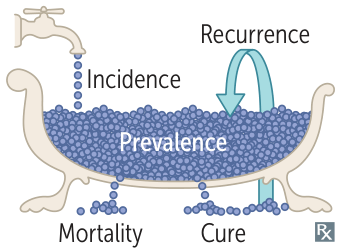
Incidence
- Definition: Measures the number of new cases of a disease that develop in a population at risk during a specified time period.
- Represents: The risk of developing a disease. It is useful for understanding the causes of a disease and how quickly it is spreading.
- Formula:
- Incidence Proportion (Cumulative Incidence) = (Number of new cases in a period) / (Population at risk at the start of the period).
- The denominator includes only those who are susceptible to the disease (i.e., do not already have it and are not immune).
- Key Application: Used in cohort studies to determine etiology and risk.
Mnemonic
Incidence looks at new cases (incidents).
Prevalence
- Definition: Measures the total number of cases (new and existing) of a disease present in a population at a specific point in time or over a period.
- Represents: The overall burden of a disease in the population. It’s valuable for planning healthcare resource allocation.
- Formula:
- Point Prevalence = (Total cases at a given point in time) / (Total population at that same point in time).
- Key Application: Measured in cross-sectional studies.
Mnemonic
Prevalence looks at all current cases.
Key Relationship & Differentiating Factors
- Formulaic Relationship: For a disease in a steady state (i.e., incidence and duration are stable), the relationship can be estimated as:
- Prevalence ≈ Incidence × Average Disease Duration.
- Impact of Disease Duration:
- For acute/short-duration diseases (e.g., common cold), prevalence is often close to incidence because people recover quickly.
- For chronic diseases (e.g., diabetes), prevalence is often much greater than incidence because cases accumulate over time.
- Factors Increasing Prevalence: High incidence, longer disease duration, effective treatments that prolong life without curing, and in-migration of cases.
- Factors Decreasing Prevalence: Low incidence, shorter disease duration (due to high fatality or high cure rate), and out-migration of cases.